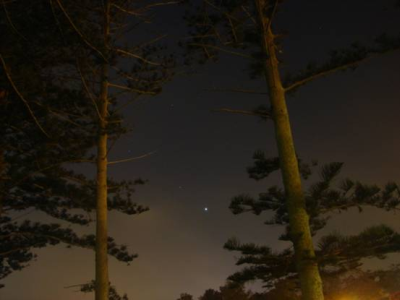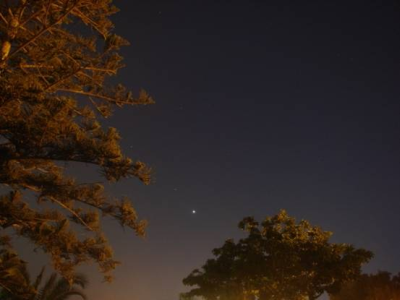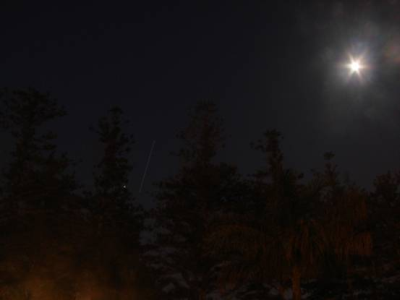26 June 2007

Venus and Saturn in the Sky of Alexandria
Venus and Saturn are the bright stars below, center. The photo was taken on 24 June 2007.
Photo by Aymen Ibrahem, Senior Astronomy Specialist
Three planets now dazzle sky watchers worldwide. Venus, our twin planet; and Saturn, the ringed wonderful planet, are in a close conjunction in the western evening sky. If you look in the direction opposite to that of Saturn and Venus, you will find another evening luminary, Jupiter, the largest planet, shining close to the southeastern horizon.
A planetary conjunction occurs when two or more planets lie close to the line of sight. It is one of the most spectacular naked-eye celestial phenomena. The Venus-Saturn conjunction will last till early July.
Mr. Aymen Ibrahem, Senior Astronomy Specialist, photographed the Venus-Saturn conjunction from Alexandria. He also made interesting observations of the International Space Station (ISS), while drifting in the sky near Jupiter, like a wandering bright star.
Venus is an eye-catching object in the western sky. Actually, Venus is the third brightest object in the sky, after the Sun and the Moon. Only on rare occasions, some comets may be brighter than Venus. In Alexandria, Venus can be found easily by looking toward the sea, during evening twilight. If the sea is not visible, the observer may simply look in the direction opposite to that of the City of Mecca to find Venus.
Venus shows phases similar to our Moon, as it is closer to the Sun than Earth. Currently, Venus is in the crescent phase. A small telescope will show Venus as a small crescent.
Saturn shines as a bright, yellowish star near Venus. They are visible among the bright stars of the zodiacal constellation Leo, the lion. The apparent distance between Venus and Saturn will be decreasing through the coming few nights. The two planets will be less than 1° apart on 1 July.
A small telescope is recommended to view this spectacular alignment. A telescope with magnification power 40x will show both planets in the same field of view, and reveal Saturn's rings and the crescent phase of Venus.

Venus and Saturn
The photo was taken in Alexandria, on 25 June 2007.
Photo by Aymen Ibrahem, Senior Astronomy Specialist
Venus (12,100 km across) is the closest planet to Earth. The minimum distance between Earth and Venus is slightly less than 40 million km, or about 100 times the Earth-Moon distance. Currently, Venus is approximately 85 million km from Earth. Saturn (120,536 km across), the second largest planet, is approximately 1,480 million km from Earth. The minimum distance between Earth and Saturn is approximately 1,200 million km.

Jupiter, ISS and the Moon
The Moon is the raying object. Jupiter shines through tree branches as a star-like object. The ISS appears as a streak, due to its orbital motion.
The photo was taken in Alexandria, on 25 June 2007.
Photo by Aymen Ibrahem, Senior Astronomy Specialist
Jupiter is approximately 660 million km from Earth. To locate Jupiter, look toward the southeast (in Alexandria, this is the direction of the City of Mecca). Ibrahem photographed the ISS while gliding in the southern sky near Jupiter. It rivaled Jupiter in brightness. It appeared as a glowing streak on the image, due to its motion.
After completing his astronomical observation, Ibrahem practiced his favorite hobby, wildlife photography. He photographed nocturnal animals including insects, frogs and garden snails.
Further Reading
Your Sky
www.fourmilab.ch/
Aymen Mohamed Ibrahem
Senior Astronomy Specialist